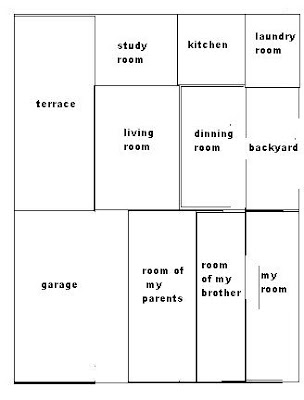
domingo, 25 de julio de 2010
Response eight
Response nine- essay on patchwork
Essay of our experience in the project of patchwork
The project of making a patchwork gave us a great opportunity to put in practice our creativity, to share our culture with people from other countries, to exchange ideas and get knowledge from others. This lesson brought beside from giving an experience to the class brought a multicultural education. The definition of multicultural education is a discipline whose major aim is to create equal educational opportunities for students from diverse racial, ethnic, social-class and cultural groups. One of its important goals is to help all students to acquire the knowledge, attitudes, and skills needed to function effectively in a pluralistic democratic society and to interact, negotiate, and communicate with peoples from diverse groups in order to create a civic and moral community that works for the common good.
The first idea I had was to make my patchwork representing my province, Limón. But, I had a lot of problems making my quilt; the first one was to know how a quilt was? What materials I can paste or sew in my piece of fabric? Then, when I decided, my creativity began to run, so I print in colors from the internet a map of Limon, I paste with glue some animals of the sea: a lobster, a crab, also a palm in the fabric and tiny little pieces of rocks to represent the sand, but that was not a great idea all the pieces felt down and the fabric was wet because of the glue, finally it was a mess. So I had to call the professor to change my piece of quilt to another.
The second idea was much better I remembered that my best friend make me a beautiful quilt of a butterfly, so I took it and sew a flower in the fabric, so it could saw much better. The professor said is much better do you sew it? Everybody laugh of course but it was perfect, I love it. Then we had to wait for the presentation of the whole quilt on Thursday.
The day of the presentation begun with a typical folklore dance of Costa Rica accompanied with marimbas, it was fun I enjoy the group presentation, then we could taste the good typical food of Costa Rica like: arroz con leche, picadillo de platano, pozol and so on. Later it was the turn of the culture and society class, everybody was nervous and expecting a good presentation of the pieces of quilt, the professor called everyone to participate, she gave the names of culture class to the exchange people in separate pieces of paper, so the idea was that they had to search for us and to talk about our culture and exchange ideas of our cultures and give clues about our pieces of quilt. My partner was a girl from Germany, she was so friendly and she wanted to know about my culture, so I start asking questions of how many days she were in Costa Rica? She said that only four days but she pretend to stay one year in our country. Then she ask me about me where I lived, then I show here the pieces of quilt and what represent each quilt she was so surprise of our creativity, then my partner apart from speaking German and English, she could speak very well Spanish but Spanish of spain, she told me that it was because her grandmother was a tourist guide in florencia, España. It was a lot of exchange information, and ideas.
lunes, 28 de junio de 2010
Response Six- Difference between both movies "Shall we dance"
Response Seven
THE VALUES AMERICANS LIVE BY
By L. Robert Kohls, Ph.D.
A guide to understand the U.S. culture and its values.
Dr. L. Robert Kohls, Director of International Programs at San Francisco State University
http://web.pdx.edu/~sbaweb/faculty/amlei/alaccess/576/ValuesAmericansLiveBy.pdf
In this particular case, this article "The values Americans live" what I understood was that they are very independent people , have a very large ego, are very positive in a 100% , they like to be under the control of everything, are open minded and so on.
miércoles, 23 de junio de 2010
Response 5: Teaching culture: Personal Relationship to cultural content
Respose 5: Learning culture: flowcharts

Respose 5: Learning culture: Maps
Response 5: Teaching culture : Analyzing Artifacts:
jueves, 10 de junio de 2010
Reponse 2- How do your beliefs, values, and cultural upbringing influence the way you behave?
Response 1 - Our first class of Culture and Society
miércoles, 9 de junio de 2010
Extra information about society and culture...
The aim of Society and Culture is to develop a student's knowledge, understanding, skills, values and attitudes essential to achieving social and cultural literacy by examining the interactions between persons, societies, cultures and environments across time.
Through the study of Society and Culture, students will develop:
knowledge and understanding about:
1. personal, social and cultural identity
2. cultures shared by members of societies
3. interactions of persons, societies, cultures and environments across time
4. continuity and change, personal and social futures and strategies for change
5. the role of power, authority, gender and technology in societies and cultures
6. the methodologies of social and cultural research.
skills to:
1. apply and evaluate social and cultural research
2. investigate and engage in effective evaluation, analysis and synthesis of information from a variety of sources
3. communicate information, ideas and issues in appropriate forms to different audiences in a variety of contexts.
informed and responsible values and attitudes towards:
1. a just society
2. intercultural understanding
3. informed and active citizenship
4. ethical research practices
5. lifelong learning.
Response 4- Culture in Second Language article
Instructional Strategies for Teaching Language and Culture:
1. Authentic Materials
2. Role Plays
3. Cultural Capsules
4. The use of films
5. Students as cultural resources
6. Literature
7. Songs


